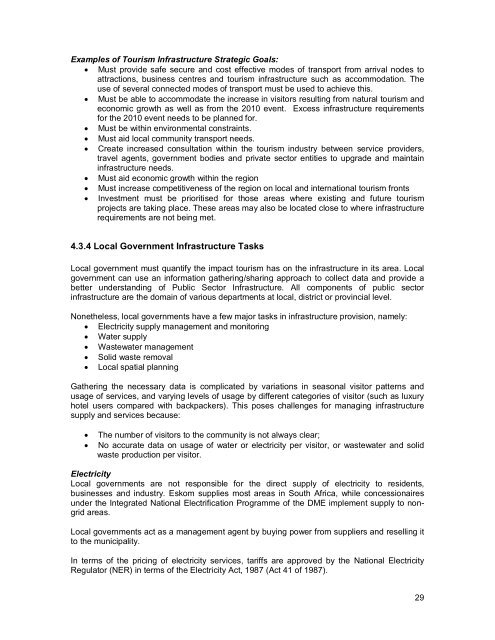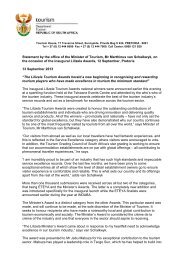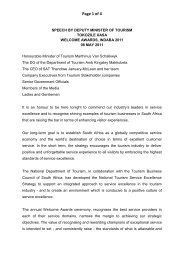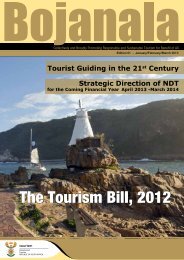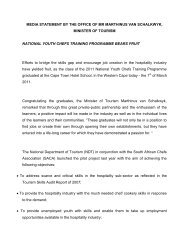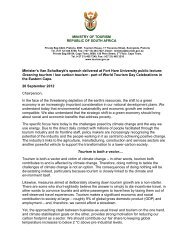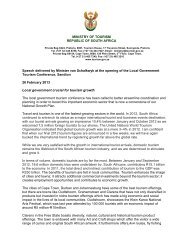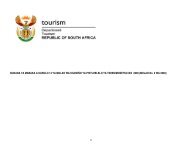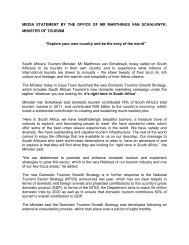The South African Tourism Planning Toolkit - Department of Tourism
The South African Tourism Planning Toolkit - Department of Tourism
The South African Tourism Planning Toolkit - Department of Tourism
You also want an ePaper? Increase the reach of your titles
YUMPU automatically turns print PDFs into web optimized ePapers that Google loves.
Examples <strong>of</strong> <strong>Tourism</strong> Infrastructure Strategic Goals: Must provide safe secure and cost effective modes <strong>of</strong> transport from arrival nodes toattractions, business centres and tourism infrastructure such as accommodation. <strong>The</strong>use <strong>of</strong> several connected modes <strong>of</strong> transport must be used to achieve this. Must be able to accommodate the increase in visitors resulting from natural tourism andeconomic growth as well as from the 2010 event. Excess infrastructure requirementsfor the 2010 event needs to be planned for. Must be within environmental constraints. Must aid local community transport needs. Create increased consultation within the tourism industry between service providers,travel agents, government bodies and private sector entities to upgrade and maintaininfrastructure needs. Must aid economic growth within the region Must increase competitiveness <strong>of</strong> the region on local and international tourism fronts Investment must be prioritised for those areas where existing and future tourismprojects are taking place. <strong>The</strong>se areas may also be located close to where infrastructurerequirements are not being met.4.3.4 Local Government Infrastructure TasksLocal government must quantify the impact tourism has on the infrastructure in its area. Localgovernment can use an information gathering/sharing approach to collect data and provide abetter understanding <strong>of</strong> Public Sector Infrastructure. All components <strong>of</strong> public sectorinfrastructure are the domain <strong>of</strong> various departments at local, district or provincial level.Nonetheless, local governments have a few major tasks in infrastructure provision, namely: Electricity supply management and monitoring Water supply Wastewater management Solid waste removal Local spatial planningGathering the necessary data is complicated by variations in seasonal visitor patterns andusage <strong>of</strong> services, and varying levels <strong>of</strong> usage by different categories <strong>of</strong> visitor (such as luxuryhotel users compared with backpackers). This poses challenges for managing infrastructuresupply and services because:<strong>The</strong> number <strong>of</strong> visitors to the community is not always clear;No accurate data on usage <strong>of</strong> water or electricity per visitor, or wastewater and solidwaste production per visitor.ElectricityLocal governments are not responsible for the direct supply <strong>of</strong> electricity to residents,businesses and industry. Eskom supplies most areas in <strong>South</strong> Africa, while concessionairesunder the Integrated National Electrification Programme <strong>of</strong> the DME implement supply to nongridareas.Local governments act as a management agent by buying power from suppliers and reselling itto the municipality.In terms <strong>of</strong> the pricing <strong>of</strong> electricity services, tariffs are approved by the National ElectricityRegulator (NER) in terms <strong>of</strong> the Electricity Act, 1987 (Act 41 <strong>of</strong> 1987).29


